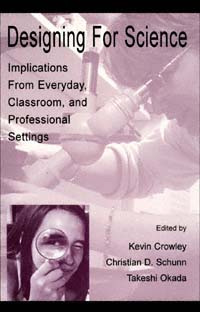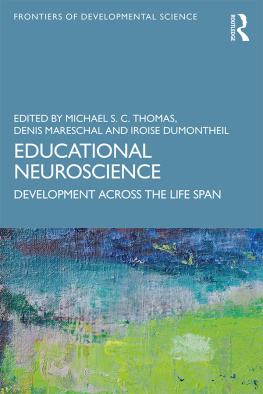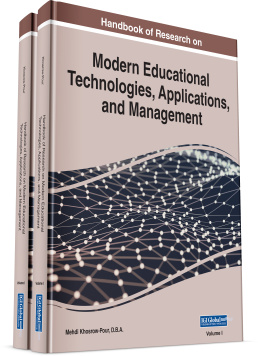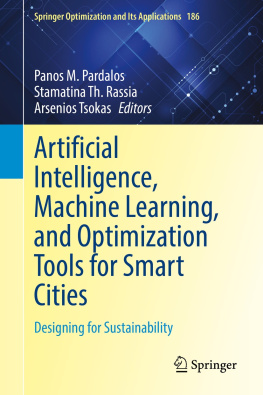Cover

| title | : | Designing for Science : Implications From Everyday, Classroom, and Professional Settings |
| author | : | Crowley, Kevin D.; Schunn, Christian D.; Okada, Takeshi. |
| publisher | : | Lawrence Erlbaum Associates, Inc. |
| isbn10 | asin | : | 0805834737 |
| print isbn13 | : | 9780805834734 |
| ebook isbn13 | : | 9780585377728 |
| language | : | English |
| subject | Science--Study and teaching, Science--Philosophy, Science--Methodology. |
| publication date | : | 2001 |
| lcc | : | Q181.D37 2001eb |
| ddc | : | 507/.1 |
| subject | : | Science--Study and teaching, Science--Philosophy, Science--Methodology. |
Page i
Designing For Science
Implications From Everyday, Classroom, and Professional Settings
Page iii
Designing For Science
Implications From Everyday, Classroom, and Professional Settings
Edited by
Kevin Crowley
University of Pittsburgh
Christian D. Schunn
George Mason University
Takeshi Okada
Nagoya University

Page iv
The final camera copy for this work was prepared by the authors, and therefore the publisher takes no responsibility for consistency or correctness of typographical style.
Copyright 2001 by Lawrence Erlbaum Associates, Inc.
All rights reserved. No part of this book may be reproduced in any form, by photostat, microfilm, retrieval system, or any other means, without prior written permission of the publisher.
Lawrence Erlbaum Associates, Inc., Publishers
10 Industrial Avenue
Mahwah, NJ 07430
Cover design by Kathryn Houghtaling Lacey
and the editors. Photographs by Takeshi Okada.
Library of Congress Cataloging-in-Publication Data
Designing for science: implications from everyday, classroom, and professional settings / edited by Kevin Crowley, Christian D. Schunn, and Takeshi Okada.
p. cm.
Includes bibliographical references and index.
ISBN 0-8058-3473-7 (cloth: alk. paper)
ISBN 0-8058-3474-5 (pbk. : alk. paper)
1. ScienceStudy and teaching. 2. SciencePhilosophy.
3. ScienceMethodology. I. Crowley, Kevin D. II. Schunn,
Christian D. III. Okada, Takeshi.
Q181 .D23 2001
507.1dc21
2001016101
CIP
Books published by Lawrence Erlbaum Associates are printed on acid-free paper, and their bindings are chosen for strength and durability.
Printed in the United States of America
10 9 8 7 6 5 4 3 2 1
Page v
Dedicated to
Joseph and Barbara Crowley
Oswin, Ute, and Gabriela Schunn
Kahichiro and Eiko Okada
Page vii
Contents
| Preface | ix |
| List of Contributors | xiii |
| PART I: FUNDAMENTALS OF SCIENCE THINKING |
| 1 | Seek and Ye Shall Find: How Curiosity Engenders Discovery |
| Herbert A. Simon | 5 |
| 2 | Explanatory Conversations and Young Children's Developing Scientific Literacy |
| Maureen A. Callanan and Jennifer L. Jipson | 21 |
| 3 | The Rhythms of Scientific Thinking: A Study of Collaboration in an Earthquake Microworld |
| Margarita Azmitia and Kevin Crowley | 51 |
| 4 | Acquiring Expertise in Science: Explorations of What, When, and How |
| Christian Schunn and John Anderson | 83 |
| 5 | What Scientific Thinking Reveals About The Nature of Cognition |
| Kevin Dunbar | 115 |
| 6 | Scientific Thinking: A Cognitive-Historical Approach |
| Ryan Tweney | 141 |
| PART II: BUILDING FOR SCIENTIFIC THINKING |
| 7 | Complexity, Emergence, and Synthetic Models in Science Education |
| David E. Penner | 177 |
Page viii
| 8 | From Cognition to Instruction to Cognition: A Case Study in Elementary School Science Instruction |
| David Klahr, Zhe Chen, and Eva Toth | 209 |
| 9 | Reconsidering the Role of Experiment in Science Education |
| Richard Lehrer, Leona Schauble, and Anthony Petrosino | 251 |
| 10 | Developing Reflective Inquiry practices: A Case Study of Software, Teacher, and Students |
| Ben Loh, Brian J. Reiser, Josh Radinsky, Daniel C. Edelson, Louis M. Gomez, and Sue Marshall | 279 |
| 11 | High Throughput Discovery: Search and Interpretation on the Path to New Drugs |
| Jeff Shrager | 325 |
| PART III: EVALUATING SCIENTIFIC THINKING |
| 12 | Epistemologically Authentic Scientific Reasoning |
| Clark A. Chinn and Betina A. Malhotra | 351 |
| 13 | Everday Activity and the Development of Scientific Thinking |
| Kevin Crowley and Jodi Galco | 393 |
| 14 | Facets of StudentsThinking: Designing to Cross the Gap from Research to Standards-Based Practice |
| Jim Minstrell | 415 |
| 15 | The Role of Hypothesis Formation in Psychological Research |
| Takeshi Okada and Takashi Shimokido | 445 |
| 16 | Internet Epistemology: Contributions of New Information Technologies to Scientific Research |
| Paul Thagard | 465 |
| Author Index | 487 |
| Subject Index | 495 |
Page ix
Preface
Since the 1980s, impressive progress has been made toward understanding how it is that people think, and learn to think, about science in each of three distinct contexts. These contexts are: 1) the practice of science by professionals pursuing research and development in laboratories; 2) the teaching and learning of science in elementary, secondary, and college classrooms; and 3) the informal science that children and adults explore in the course of everyday activities at home or at institutions such as museums. A major component of this progress has been an increased focus on the context-specific aspects of scientific reasoning. For example, a good understanding of science is not going to help you design a good science curriculum unless you also understand a lot about a school and about the way the teachers and students interact. The same can be said for professional science or everyday science.
Next page







